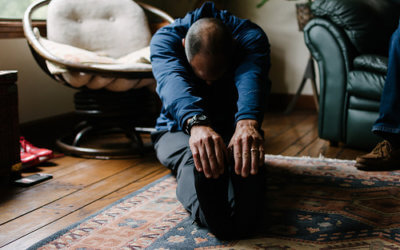Feeling Suicidal or Like Self-Harming? Techniques to Stop Distress

By: Martin Cooper
by Andrea M. Darcy
Is there anything at all you can do to help yourself climb out the hole when feeling suicidal? Or when self-harming thoughts hit?
How to stop feeling suicidal
Many, many people experience suicidal thinking, and it does not mean you are hopeless or flawed. It just means your mind is overwhelmed and you’ve dealt with a lot.
Recognise that you are not your thoughts
All those crazy, destructive thoughts in your head? They are not who you are. They are just negative thoughts. And you are not your thoughts, you are something bigger.
Take a moment to repeat that a few times and feel into it. Say it out loud if it helps. “I am not my thoughts.” And breathe deeply, focusing on the now moment. Can you feel a sense of space between your thoughts and something else, another ‘you’?
Shift your perspective if you are feeling suicidal
Not sure you can believe you are not your thoughts? Or even your actions? If you were suddenly handed a million pounds, all yours, no question asked, and told you could have an entirely new identity and start again? Would you still be thinking what you are thinking right now?
What just happened there was what is called a perspective shift. In this moment, you are stuck in a harsh perspective. But it is not who you are.
Learn the power of TIPP skills
The next few techniques are about shocking you out of your overwhelming emotions. They might sound weird at first.
But if you can even manage to do one when you feel suicidal or like self harming, it can help. These are based on “TIPP skills” for managing distress that form part of dialectical behaviour therapy (DBT).
The idea is to create a brief window away from your intense pain, so that you can focus enough to use coping techniques that offer longer results and push you farther out of your distressed thinking. You might be able, for example, to have enough energy to call that friend.
TIPP skills is an acronym for Temperature of your face, Intense aerobic exercise, Paced Breathing, and Paired Muscle relaxation.
1. Cold water and ice.

By: kizzzbeth
Cold showers and ice baths have become popular anxiety techniques due to Wim Hof the ‘Ice Man’ and his hormetic stress tools.
But don’t worry, you don’t have to immerse yourself in ice!
It’s been found that cold water on your face combined with holding your breath (triggering the ‘human dive reflex’) is itself enough to lower emotional arousal and make you feel back in charge of yourself again.
Simply hold your breath and dunk your face in a sink of cold water for between 30 and 60 seconds. You don’t want the water to be so cold it hurts, just cold enough to feel shocking. You might need to do it a few times. (*Note that this technique has a powerful enough affect on your body it’s not recommended if you have a heart condition or are physically weak).
Some people find that holding ice cubes can be just as effective, and can distract from the urge to self-harm.
If you feel you are going to self-harm, grab some ice cubes in a Ziploc or wrapped in paper towels and hold them in your hand. The intense sensation becomes a stand in for the escapist sensation of self harm, helping the desire pass.
2. Breathe from the gut.

By: A Rod
Breathe from your diaphragm ( put a hand on your bellybutton, and aim to make your hand rise and fall).
You want to start taking long, slow, deep breaths, and your out breath can be longer than the in breath.
Count in your head so that you reach a pattern, such as four counts in, eight counts out, four counts in, eight counts out. This is called “Paced Breathing” in DBT.
It might feel boring. Keep going. If you can do this for up to ten minutes or so, you’ll feel real results. Remember, you are creating a window here, where you can feel a tiny glimmer of yourself beneath your suicidal or self-harming urge.
If you can, pull up an image of something that is positive in your mind, even if it’s silly, like a kitten or puppy or field of flowers. Try to think about it as much as you can as you do this breathing. Be careful here. Only use a neutral image, not someone who you love but who upsets you.
3. Travel from the mind to the body.
Get away from your churning thoughts with a bit of body-based mindfulness. Put your attention on your feet. Just really notice that your feet are fully on the ground. Stamp them a bit. How does it feel? Focus on your feet or another body part for as long as it feels good and brings you any peace.
Or, you might want to slowly but surely put your attention on each bit of your body, working upwards from your feet, or down from your head (this is called a ‘body scan’ in mindfulness).
Another proven technique used by DBT to get you out of distress is around muscle work, called ‘paired muscle relaxation’. Basically, it involves clenching then releasing all your major muscle groups while breathing in and out.
A very simplified start here can be to repetitively clench your hands as tight as you can into fists while breathing in, then relaxing your hands fully open, breathing out.
[Read our article on progressive muscle relaxation to try a full sequence – it’s proven by science to leave you feeling relaxed and better.]
4. Move it on out when feeling suicidal.

By: Adam McGuffie
If you jump up and down, put music on and force yourself to dance through an entire song? Or can manage to put one foot in front of the other and walk around the block a few times?
Your body chemistry will fight back long enough to give you a slight lift so that your other ways of coping can work.
Ideally, you need to keep up the exercise for 20 minutes.
Again, don’t take our word for it, try it. Dialectical behaviour therapy calls this “Intense Exercise”. Getting your heart rate up to 70% the recommended intensity for your age is shown to increase positive emotions.
Read our piece on ‘How to exercise even if you are depressed‘ for more on exercise and mood.
[And note that it’s important to use music that is upbeat and makes you feel good. Sad music is shown to have a negative effect on mood.]
5. Call the right person.
Using the body-based techniques above, you have created a gap between you and your distress big enough to take a more powerful action against your destructive thoughts. You know the best one already… reach out.

By: Alon
If you know someone you trust to help, and you now feel enough energy and drive to call them? Do it.
Don’t overthink it, just call or text.
Of course don’t call anyone who might make you feel worse or not understand. Put yourself first here.
If you are desperate to talk to someone, but just don’t have someone to trust, do call a hotline. Don’t feel weird about it. Millions of people call these hotlines each year. That’s what they are there for. Don’t feel it’s not manly, either. Reaching out for help is a strong thing to do, and there is a hotline in the UK just for men (listed below). The trained listeners on the other end of the line are happy to talk to you. They are there because they want to be. They want to help you. Just call.
And you know what we say now…
If you really feel you are going to hurt yourself, or someone else, please, do use emergency services. You can go to any hospital A&E department, or call 999 for an ambulance (or get someone else to call 999 for you). If you don’t want to go to the hospital, you can also call NHS emergency services at 111. NHS 111 is open 24 hours a day, every day of the year, and it’s free to call from any type of phone.
Hotlines to call if you feel suicidal in the UK
Samaritans (116 123) – This hotline is open 24-hours a day, 365 days a year. If you hate talking on the phone or don’t have privacy you can email them at [email protected] and get a response that way.
SANEline (0300 304 7000). This is a national after-hours hotline open from 4:30 p.m. to 10:30 p.m., 3645 days a year.
Childline (0800 1111) – This hotline is for you if you are a kid or even a teen. You can call it, and the number won’t show up on the phone bill, so nobody in your family needs to know. You can also go to their site to have a online chat.
HOPELineUK (0800 068 41 41) – this is a hotline just for teens and people under 35 who are feeling suicidal. It’s open 10am to 10pm weekdays and 2pm to 10pm weekends and holidays.
CALM (0800 58 58 58) (Campaign Against Living Miserably) – this is for you if you are a young man feeling depressed. They are open for calls from 5 to midnight, all year round.
The Silver Line (0800 4 708090) This is a charity for older people that provides advice and friendly chats 24 hours a day, every day of the year.
Nightline is a website for students, and connects yo to your university or college’s night-time listening service. You’ll be talking to other students who understand what you are going through.
Sometimes feel suicidal? Stop living a half-life. Reach out for proper support. Harley Therapy connects you with experienced and kind counsellors and psychotherapists in central London. Or use our sister site to find affordable therapists across the UK, and you don’t even need to leave the house, as many offer online counselling.
Do you want to share your story about surviving feeling suicidal with our readers? Use the public comment box below.
 Andrea M. Darcy is a mental health writer and mentor and currently the editor and lead writer of this site. She has experienced suicidal thinking since adolescence and knows these techniques help. Find her on Twitter and Linkedin.
Andrea M. Darcy is a mental health writer and mentor and currently the editor and lead writer of this site. She has experienced suicidal thinking since adolescence and knows these techniques help. Find her on Twitter and Linkedin.





That was so useful. Thank you.
Really glad to be of help, Lindsay!
I know that I am the only person who can help myself; no one else can do it for me. But until I read this article, I didn’t know what to do. Thank you for putting out this information. I did not know the ice cube/cold water trick.
I’ve needed a way to manage my emotions but I didn’t have any strategies.
Glad to help, Bee. Give the different techniques a try, sometimes it’s the one we think won’t suit us that does in the end, and vice versa. And as for ‘I am the only person who can help myself’, that sounds pretty lonely. In fact others can help us out a lot, and sometimes we all need that extra help. If you are feeling suicidal or are self-harming, it’s a great idea to reach out for some support, even if it’s just calling a free help line http://bit.ly/mentalhelplines. If you are on a low budget, we have an article here on how to get free or low cost counselling http://bit.ly/lowcosttherapy. It can seem scary to let others help us and admit we need help, but it’s often a step in an all new direction. We wish you courage!